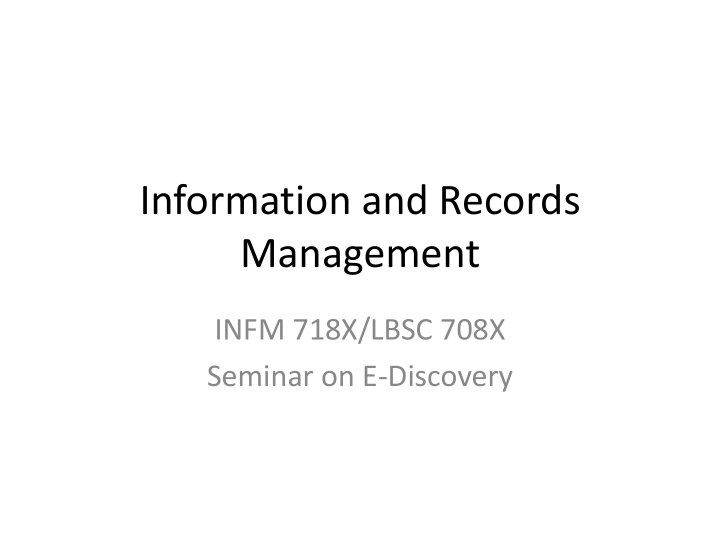



Information and Records Management INFM 718X/LBSC 708X Seminar on E-Discovery
Agenda • Information management • Records management • Discussant
The EDI Trinity • Data • Information • Records
Sources of ESI • Enterprise databases • File systems – Metadata • Web sites – Deleted files • File systems • Security badge access logs – Organized • Personally owned systems – Shared – Personal – Files – Email • Email • Cloud services • Backup tapes – Gmail/Hotmail/… • Voicemail – Dropbox /Google Docs/… • Instant messaging – Facebook – Twitter – SMS
Formal and Informal Social Networks
The Activity Trinity • Use • Retain – Proactive (records management) – Reactive (legal hold) • Destroy – Reasonable (cost, business risk, …) – “Bad faith” (litigation risk)
Internal Stakeholders • Business functions – Operations – Sales – Management (audit, …) – Support functions (purchasing, human resources, …) • Information technology staff • Records management staff • Legal staff
Who to Believe?
Replication • Business continuity • Disaster recovery • Parallel access • Latency mitigation • Leakage – Convenience – Unauthorized disclosure – Theft – Disposal
IT Support Functions • Management (CIO, CTO, projects, audit, …) • Acquisition (systems, services, outsourcing, …) • Development (software, Web, migration, …) • Operations (servers, network, backups, …) • Security (network, data, …) • Support (training, help desk, …)
Management Structures • Execution • Network architectures – Centralized – Workstations – Distributed – Cloud – Peer-to-peer • Control • Centralized Functions – Centralized – Relational database – Distributed – Servers • Mail • Web – Backups
Critical Events • Hardware refresh – Migration, concurrent operations • System upgrade – Backward compatibility • Change of outsourcing contractor – Service Level Agreement (SLA) continuation • Termination of employment – ESI, tacit knowledge, file encryption passwords
Risk Management • Awareness – Training – Detection – Red team • Mitigation – Proactive • Technology • Policy • Process – Reactive
Information Management Policies • Access control (systems, FERPA, classified, …) • Change control (Content, authorization, …) • Acceptable use (personal use, malicious use , …) • Dissemination control (Web sites, blogs, …) • System integrity (wireless devices, media, …) • Privacy (rights, assurances, …) • Backup management (periodicity, restoration, …) • Legal holds
Sedona Guidelines 1. Information and records management is important in the electronic age 2. An organization’s information and records management policies and procedures should be realistic, practical, and tailored to the circumstances of the organization 3. An organization need not retain all electronic information ever generated or received
Sedona Guidelines (cont.) 4. An organization adopting an information and records management policy should also develop procedures that address the creation, identification, retention, retrieval and ultimate disposition or destruction of information and records 5. An organizations policies and procedures must mandate the suspension of ordinary destruction practices and procedures as necessary to comply with preservation obligations related to actual or reasonably anticipated litigation, government investigation or audit
Defining “Records” • ISO 15489-1:2001: Information created, received and maintained as evidence and information by an organization or person in pursuance of legal obligations or in the transactions of business” • ICA Committee on Electronic Records: A recorded information produced or received in the initiation, conduct or completion of an institutional or individual activity and that comprises content, content and structure sufficient to provide evidence of the activity.
Records Management • “Schedules” – What – How long – (Why) • Classification – Specialized staff (e.g., executive assistant) – End-user (e.g., for email) – Embedded rules (hand-written or learned)
Information Life Cycle
Famous Last Words • Word of the day: spoliation – Destruction or altering of evidence • “There are some communications that should not be put in written form” – (hmmm … how is it that we know this was said?)
Recommend
More recommend